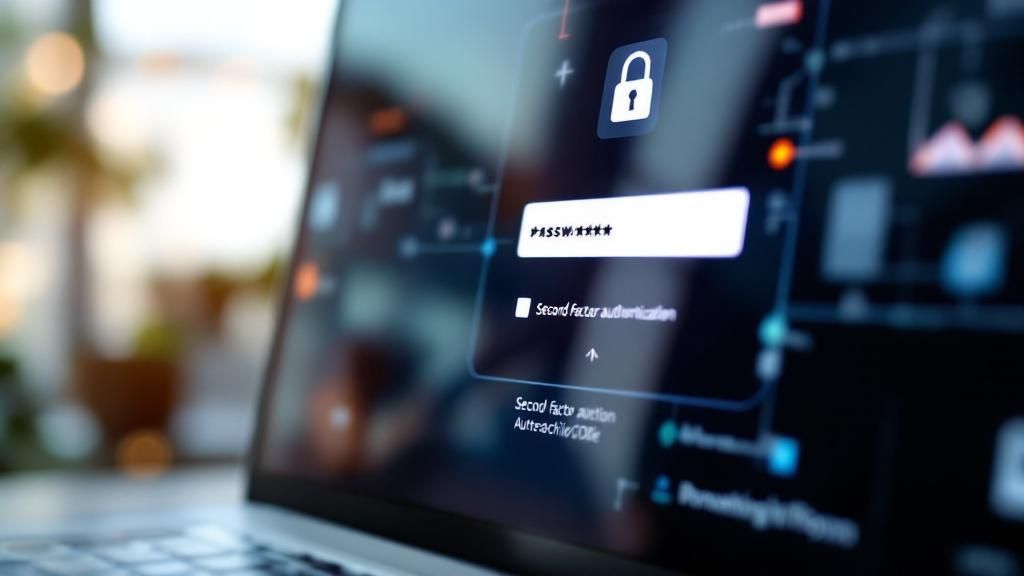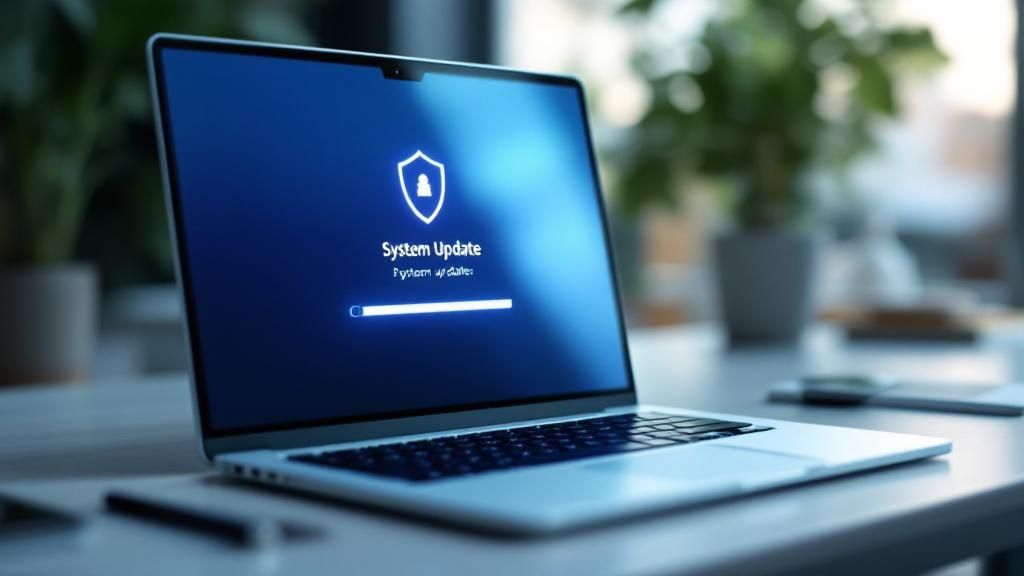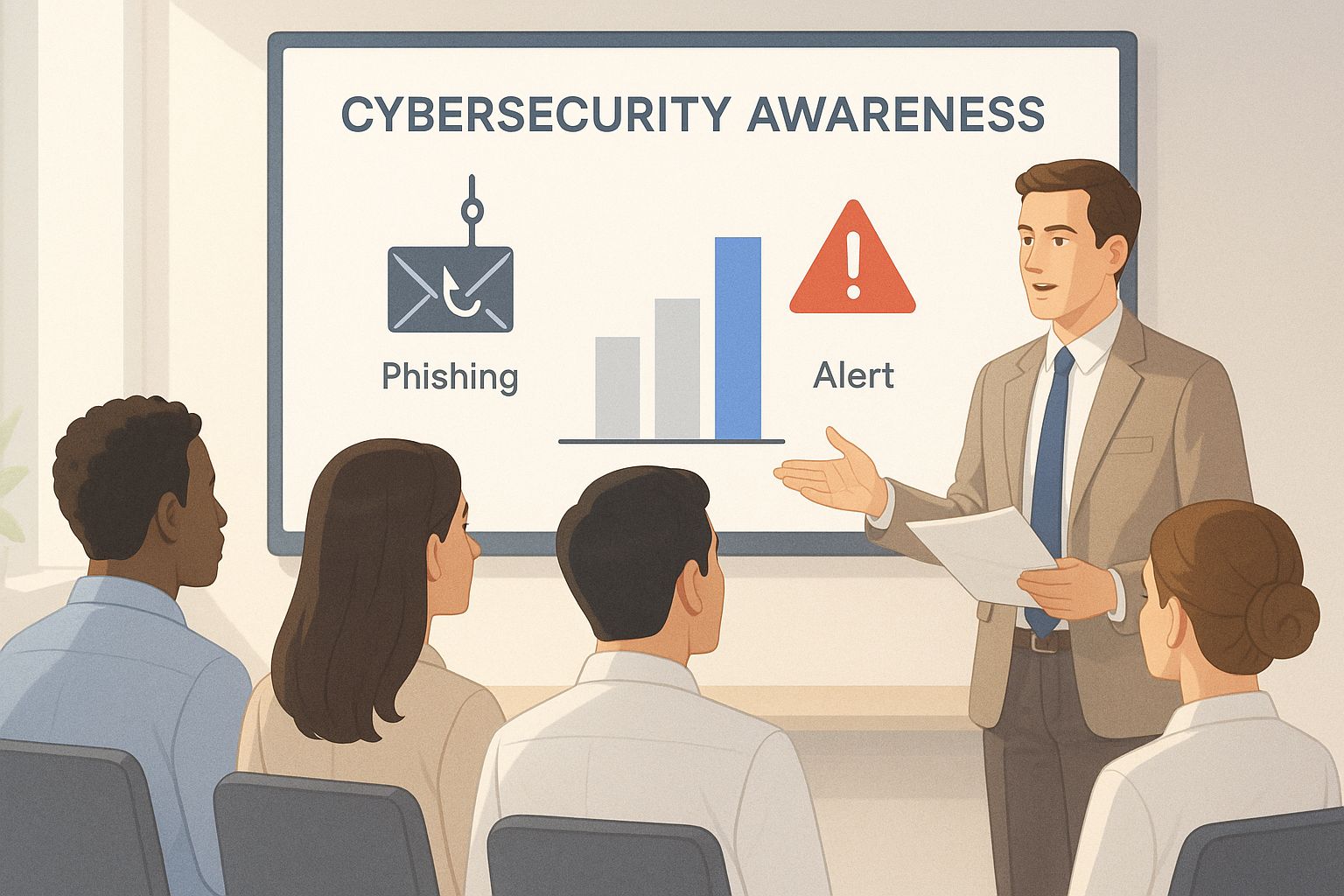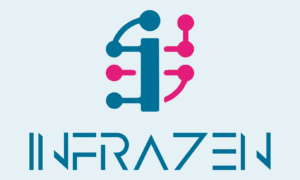Before you can fend off a cyber attack, you have to understand where you’re actually vulnerable. It's all about figuring out what your most valuable digital assets are-things like client data and intellectual property-and then realistically mapping out how someone might get to them. This first look is the bedrock of any solid security plan.
Pinpointing Your Business's Biggest Cyber Risks

To build a decent defence, you first need to know where the weak spots are. The best way to do that? Start thinking like an attacker.
This isn’t about becoming a security guru overnight. It’s more of a practical exercise. You need to look at your business through a different lens-one that’s always searching for an easy way in.
Start With What Matters Most
Any meaningful risk assessment kicks off by identifying your digital crown jewels. For a creative agency, this could be anything from client lists and unreleased designs to your proprietary marketing strategies.
Think about where this critical information lives. Is it sitting in a shared cloud drive, on a local server in the office, or spread across individual employee laptops? Each of these locations comes with its own unique set of risks.
For example, a client database stored in the cloud might be safe from a fire, but it’s a prime target for a phishing attack that tricks an employee into giving up their login details. Understanding these weak points is the first step, but truly effective prevention involves implementing essential cyber security risk management techniques.
Map Out Potential Threats
Once you know what you’re protecting, you can begin to picture how an attacker might try to get their hands on it. It’s much more helpful to think in terms of real-world scenarios rather than vague, abstract threats.
These scenarios don’t have to be wildly complex. Often, it’s a simple mistake that opens the door to a major breach.
- Insecure File-Sharing: A team member shares a link to a folder with sensitive client mock-ups but forgets to password-protect it or set an expiry date. An attacker could stumble upon this link through a simple search if it’s indexed, or if the email is accidentally forwarded.
- Compromised Contractor Account: The freelance designer you’re working with uses the same weak password for everything. If another service they use gets breached, attackers now have credentials they can try on your shared project management tool.
- Outdated Software: Your website’s content management system has a known security flaw, but no one has applied the update. Attackers are constantly scanning the web for these unpatched systems, making them incredibly easy targets.
Spotting these potential failure points isn’t about playing the blame game. It’s about cultivating a proactive mindset across the team that helps you find and fix security gaps before they can be exploited. This shift is what makes all the difference.
Weighing Likelihood Against Impact
Not all risks are created equal. The trick is to focus your time and money where they’ll have the biggest impact. A straightforward way to do this is to weigh the likelihood of an attack against the potential damage it could cause.
Thinking about the bigger picture helps here. In the UK, around 43% of businesses reported some kind of cyber security breach or attack in the last year. That’s a huge number, and it underscores why every business needs to take this seriously.
A full cybersecurity risk assessment provides a structured way to categorise these threats, but you can start with a simple matrix. The goal is to pour most of your resources into tackling the "High Likelihood/High Impact" category-these are the threats that should keep you up at night.
Cyber Security Risk Prioritization Matrix
Here’s a simple matrix to help you sort through potential threats and decide what to tackle first. By assigning a likelihood and impact score to each risk, you can quickly see what needs immediate attention.
| Threat Type | Likelihood (Low/Medium/High) | Potential Impact (Low/Medium/High) | Priority Level |
|---|---|---|---|
| Ransomware on Main Server | Medium | High | CRITICAL |
| Phishing Attack on Staff | High | High | CRITICAL |
| Freelancer Credential Theft | High | Medium | HIGH |
| Outdated Website Plugin | High | Low | MEDIUM |
| Office Wi-Fi Breach | Low | Medium | MEDIUM |
| Physical Theft of Laptop | Low | Low | LOW |
This kind of prioritisation ensures you're not just busy, but effective. You're applying your efforts to the areas that pose the greatest danger to your creative business, protecting your work, your clients, and your reputation.
Creating Security Policies That Actually Work

Real security isn't just about software-it's built on clear, practical rules that your team can actually follow. Far too many businesses draft dense, legalistic documents that end up collecting digital dust in a forgotten folder. To prevent a cyber attack, your policies have to be understood, respected, and woven into the fabric of daily work.
The goal is to create guidance that feels helpful, not restrictive. A policy that makes sense for a software developer handling source code will look completely different from one for a marketing agency managing client social media accounts. This custom-fit approach is what makes the rules stick.
Moving Beyond Generic Templates
Templates are a decent starting point, but they rarely capture what makes your creative business tick. Your policies need to address the real-world situations your team faces every day, turning abstract security concepts into concrete actions. This is where you define the "how" behind your security strategy.
For instance, don't just have a vague rule about "protecting data." Get specific. Define what "sensitive data" means for your business. For a design studio, this could be unreleased client artwork and brand concepts. For a marketing consultant, it might be customer analytics and campaign performance metrics.
A great security policy is a living document. It shouldn't feel like a top-down decree but rather a shared agreement on how to protect the creative work you all care about. When people understand the 'why' behind a rule, they are far more likely to follow it.
If you’re looking for a solid foundation to build on, you can learn how to structure your guidelines using a well-organised IT security policy template and then adapt it to fit your team’s specific needs.
Core Policies Every Creative Business Needs
While your policies must be tailored to you, a few core areas are non-negotiable for any business that wants to fend off cyber attacks. These foundational rules create a baseline of security that protects everyone.
Here are the essentials to get you started:
- Acceptable Use Policy (AUP): This sets clear expectations for using company equipment and networks. It should cover things like installing personal software on work laptops or which websites are off-limits on the office Wi-Fi.
- Password Management Policy: This needs to go beyond just telling people to use strong passwords. It should mandate a password manager, enforce multi-factor authentication (MFA) on all critical accounts, and set a schedule for changing passwords on any shared accounts.
- Data Handling Policy: Here’s where you outline how different types of information are stored, shared, and eventually deleted. It should specify which cloud services are approved for client files and which platforms are forbidden for sharing sensitive info.
- Remote Work Policy: With flexible working now the norm, you need clear rules for securing home networks and personal devices. This policy should define requirements for secure Wi-Fi setups and mandate the use of a VPN for accessing company resources from outside the office.
Making Your Policies Practical and Accessible
The best policies in the world are useless if no one reads them. Ditch the overly technical jargon and long, intimidating paragraphs. Present your guidelines in a way that's easy to scan, understand, and remember.
Think about how your team actually consumes information. Would a short video explaining the password policy be more effective than a three-page document? Could you create a simple one-page checklist for new hires covering the most critical security rules?
Here’s a look at the old way versus a much more practical approach:
| Traditional Policy | Practical and Accessible Policy |
|---|---|
| Long, text-heavy PDF document. | An interactive page on your company intranet. |
| Uses formal, legalistic language. | Written in plain, simple English with clear examples. |
| One-size-fits-all rules for everyone. | Role-specific guidance for different teams. |
| Buried in a shared drive, hard to find. | Includes quick-reference guides and checklists. |
Ultimately, the format matters less than the outcome. Your policies succeed when they become a natural part of your team's workflow, helping everyone make smarter, safer decisions without a second thought.
Deploying Your Core Technical Defences
With clear policies in place, it’s time to install the tech that forms your first line of defence. Knowing how to prevent a cyber attack isn't about buying expensive, complicated software; it's about deploying a few core, high-impact technical controls and getting them right.
For most small to medium-sized UK businesses, a handful of non-negotiable tools can stop the vast majority of common threats. These are the foundational layers that safeguard your devices, your network, and your accounts from opportunistic attackers.
Building Your Digital Perimeter
Think of a firewall as the digital gatekeeper for your network. Its one job is to inspect all incoming and outgoing traffic, blocking anything that looks suspicious or doesn't follow the rules you've set.
Most modern internet routers come with a basic firewall built-in, but you need to make sure it's actually turned on and configured properly. This is your first and most basic barrier-a simple, set-and-forget tool that works silently in the background to keep unauthorised visitors out.
Securing Every Endpoint
Every device that connects to your network-laptops, desktops, and even company mobiles-is an "endpoint." And each one is a potential entry point for an attacker. A firewall isn't enough; you also need to protect the devices themselves.
This is where endpoint protection software, often called antivirus or anti-malware, comes in. Modern solutions do far more than just scan for viruses. They actively monitor device behaviour to spot and block suspicious activity, like a program trying to encrypt your files in a ransomware attack. It's critical to ensure every company device has up-to-date endpoint protection, especially for remote teams connecting from less-secure home networks.
The Power of Multi-Factor Authentication
If there's one technical control that offers the biggest security return for the least effort, it's multi-factor authentication (MFA). Most cyber attacks start with a compromised password. MFA stops these attacks cold.
It works by requiring a second form of verification in addition to the password, typically a code sent to a mobile app or a text message. Even if an attacker steals a password, they can't get in without physical access to the user's phone.
Mandating MFA across all your critical applications-email, cloud storage, financial software-is one of the most effective steps you can take. It’s a low-cost measure that instantly neutralises the threat of stolen credentials, which account for a huge number of security breaches.
The infographic below highlights the importance of raising team awareness about common threats, which is a key part of making your technical defences effective.

This visualisation underscores that technology alone isn't enough-your team needs to understand the threats they face to use these tools effectively.
Don't Forget Wi-Fi and Backups
Your office Wi-Fi is another potential weak spot. Never use the default password that came with your router; always change it to something strong and unique. For added security, create a separate guest network for visitors. This isolates their traffic from your main business network, preventing anyone from snooping on sensitive company files.
Finally, a reliable data backup system is your ultimate safety net. If the worst happens, having recent, clean backups means you can restore your data and get back to work quickly without paying a ransom. Automate your backups to run daily and test them regularly to ensure they actually work.
Keeping all your software updated is also a crucial part of your defence. Applying security patches promptly closes vulnerabilities that attackers love to exploit. To better understand this process, you can learn more about what patch management is and how it strengthens your security posture.
Comparing Security Tools for Small Businesses
Choosing the right security tools can feel overwhelming, but focusing on a few key controls provides a strong foundation. The table below breaks down the essentials, what they do, and the typical effort involved for a small business to get them up and running.
| Security Control | Primary Function | Example Solutions | Implementation Effort |
|---|---|---|---|
| Firewall | Blocks unauthorised network access. | Built-in router features, dedicated hardware (e.g., Ubiquiti, Fortinet). | Low (for router), Medium (for dedicated hardware). |
| Endpoint Protection | Prevents malware on individual devices. | Bitdefender, SentinelOne, Microsoft Defender for Business. | Low to Medium. |
| Multi-Factor Authentication (MFA) | Secures accounts against password theft. | Google Authenticator, Authy, Microsoft Authenticator. | Low. |
| Data Backups | Enables recovery from data loss or ransomware. | Veeam, Acronis, cloud provider tools (e.g., Azure Backup). | Medium. |
These controls work together to create layers of defence. While no single tool is foolproof, combining them significantly reduces your risk and makes your business a much harder target for cybercriminals.
Turning Your Team into a Human Firewall
Your technical defences are essential, but they can't stop everything. Let's be honest, many of today's most damaging attacks don't bother with your software-they go straight for your people.
This is why turning your team into your strongest security asset is one of the most effective moves you can make.
A once-a-year PowerPoint on security just doesn't cut it anymore. Attackers are constantly sharpening their tactics, so your team's awareness needs to be just as dynamic. The goal is to build a lasting culture of security, embedding safe habits into the daily workflow, not just ticking a box.
Making Training Stick
The secret to successful training? Relevance. Your team needs to see exactly how security principles apply to their roles. Generic examples fall flat; you have to show them the kind of threats they're likely to face day-to-day.
A great starting point is understanding the fundamentals of what you're trying to achieve. Learning What is Security Awareness Training? moves you beyond theory and into practical, skill-building exercises that actually work.
Instead of a long lecture, try breaking training into smaller, more frequent sessions. Focus on spotting phishing emails one month, then move on to secure data handling the next. This continuous approach keeps security front and centre, right where it needs to be.
Teaching Your Team to Spot Phishing
Phishing is still one of the most common ways attackers get a foot in the door. Training your team to scrutinise every message is a critical skill. Go beyond the obvious "Nigerian prince" scams and show them the sophisticated, tailored examples that target creative businesses specifically.
Here are a few real-world phishing scenarios you can walk them through:
- The Urgent Invoice Ploy: An email lands, seemingly from a regular supplier, with an "overdue" invoice attached. The language is urgent, pressuring the recipient to click and pay before they have a chance to think twice.
- The Fake Cloud-Sharing Lure: A notification that looks like it's from Dropbox or Google Drive says a client has shared a new design file. The link, however, goes to a pixel-perfect fake login page designed to steal their password.
- The Bogus Supplier Update: An attacker impersonates a vendor you work with all the time, claiming they've updated their bank details. They'll ask your accounts team to use the new information for all future payments.
The most convincing phishing emails often have no obvious red flags. They rely on creating a sense of urgency, authority, or curiosity to bypass our natural caution. The single best defence is a healthy dose of scepticism-especially for any message that asks for credentials, money, or sensitive data.
Recognising Social Engineering Tactics
Phishing is just one flavour of social engineering-the art of manipulating people into giving up confidential information. Attackers might use phone calls, social media DMs, or even show up in person to get what they want.
Train your team to recognise these common manipulation tactics:
- Creating a Sense of Urgency: Attackers will often insist that something must be done immediately to prevent a disaster. This pressure is designed to make people act before they think.
- Impersonating Authority: They might pretend to be a senior manager, an IT admin, or even someone from a government agency to intimidate the target into complying without question.
- Appealing to Helpfulness: Some attackers feign distress, pretending they're locked out of an account and just need a little help resetting a password or getting some information.
Fostering a Blame-Free Reporting Culture
This might be the most crucial part of building your human firewall: creating a safe environment for reporting mistakes. If an employee clicks a dodgy link, they should feel empowered to report it immediately, without fearing punishment.
Set up a clear, simple, and blame-free process for reporting anything suspicious. This could be a dedicated email address or a specific person to contact. When someone does report a potential issue, thank them for their vigilance, even if it turns out to be a false alarm. This positive reinforcement encourages everyone to speak up.
Shame and fear are the enemies of good security. A team that feels safe reporting incidents is a team that can stop a small mistake from turning into a major catastrophe.
Staying Ahead with Active Monitoring and Response
Cyber security isn't a one-and-done project. Once your defences are up, the real work begins-keeping a constant watch on your systems and knowing exactly what to do the moment something feels off. This turns security from a passive checklist into an active, living part of how you run your business.
Learning how to prevent a cyber attack also means learning to spot the early warning signs. You don’t need to be a security expert to do this. It all starts with simple, consistent habits.
Keeping a Watchful Eye on Your Systems
The word "monitoring" can sound a bit heavy, but for a creative business, it just means paying attention to the basics. All your systems-from your website to your cloud services-generate logs that tell a story of who is doing what, and when.
Getting into the habit of checking these logs is surprisingly powerful. You’re looking for anomalies, things that just don’t fit the normal pattern of your workday. Better yet, setting up automated alerts for unusual activity can do most of the heavy lifting for you.
Here’s what you should be keeping an eye on:
- Unusual Login Attempts: Get an alert for multiple failed login attempts on one account or successful logins from weird locations. If your whole team is in the UK, a login from another continent at 3 AM is a massive red flag.
- Privilege Escalation: Be notified if a standard user account is suddenly granted admin rights. This is a classic move attackers make right after they get a foot in the door.
- Large Data Transfers: An alert for unusually large files being downloaded or moved out of your network could be the first sign someone is stealing your data.
Effective monitoring is a cornerstone of solid security operations. To get deeper into this, check out our guide on managing security operations to build a more resilient defence.
Creating Your Incident Response Plan
When you suspect an attack, panic is your worst enemy. A clear, simple incident response plan is your emergency playbook. It guides your team through the critical first hours of a breach with calm and precision.
A plan transforms a potential catastrophe into a manageable event. It replaces confusion and guesswork with a clear sequence of actions, drastically minimising the damage to your business and reputation.
The financial stakes are very real. Past estimates have shown that cyber crime costs UK businesses an average of £4,200 per incident, highlighting the direct financial hit these events can cause. An incident response plan is a non-negotiable step in protecting your bottom line. You can find more UK-specific data in the latest cyber crime statistics.
Your plan doesn't need to be a hundred-page novel. A simple one-page document covering the essentials is far more effective than a complex manual nobody can find in a crisis.
The Four Core Steps of Incident Response
A practical plan for a creative business boils down to four key stages. Think of it as a cycle: Prepare, Detect, Contain, and Recover.
Here’s a simple breakdown of what each step involves and who should own it.
| Stage | Key Actions | Who is Responsible? |
|---|---|---|
| Preparation | Create contact lists, ensure backups are working, and train the team on the plan. | Business Owner / Operations Manager |
| Detection | Monitor for alerts, report suspicious activity immediately using a clear process. | All Team Members / IT Partner |
| Containment | Isolate affected devices from the network, change compromised passwords, block attacker access. | IT Partner / Designated Tech Lead |
| Recovery | Restore data from clean backups, analyse the root cause, and improve defences. | Business Owner / IT Partner |
In a real incident, the most important step is containment. The goal is to stop the bleeding. This might mean yanking a server offline or telling an employee to disconnect their laptop from the Wi-Fi immediately. Quick containment stops an attacker from digging deeper into your network and doing more damage. Having this playbook ready is a vital part of knowing how to prevent a cyber attack from spiralling out of control.
Answering Your Cyber Security Questions
Even with a solid plan, it’s natural to have questions. When it comes to protecting your business, there’s no such thing as a silly one. Here are the honest answers to a few questions we hear all the time from creative businesses across the UK.
If We Can Only Do One Thing, What’s the Single Best Step to Improve Security?
Easy. Make Multi-Factor Authentication (MFA) mandatory on every single account. If you take away just one piece of advice today, let it be this.
The overwhelming majority of security breaches boil down to one thing: a compromised password. MFA completely neutralises this threat by requiring a second step for verification, like a code sent to a mobile app. Even if an attacker steals a password, they can’t get in. It’s a low-cost, high-impact move that instantly raises your defences.
So many business owners I speak to are surprised by how simple and effective MFA is. It slams the door on the most common attack method out there and makes life incredibly difficult for anyone trying to access your accounts.
How Often Should We Be Running Security Training for Our Staff?
Let’s be blunt: annual training just doesn’t cut it anymore. For your team to build a real security-aware culture, the conversation needs to be continuous, not a once-a-year tick-box exercise.
We find that a blend of activities works best. Think about running formal training sessions twice a year to cover the fundamentals and any new threats. Then, keep the momentum going with quarterly phishing simulations to test awareness and drop quick security reminders into team meetings or emails. This keeps security at the front of everyone's mind where it belongs.
Are We Genuinely a Target for Cyber Criminals? We’re Just a Small Studio.
Yes, without a doubt. It’s a dangerous misconception that attackers only go after big corporations. In reality, criminals often specifically target smaller businesses because they assume security will be weaker. They use automated tools that constantly scan the internet for easy targets, regardless of their size.
Your business holds incredibly valuable information-client data, financial details, intellectual property-all of which has a price on the black market. Proactive defence isn't just for the big players; it’s absolutely essential for everyone.
At InfraZen Ltd, we take the complexity out of cyber security, so you can focus on your creative work. Our ZenCore service plans provide the proactive monitoring, resilient backups, and expert guidance your business needs to stay safe and productive. Discover how we can bring calm and reliability to your tech today.

